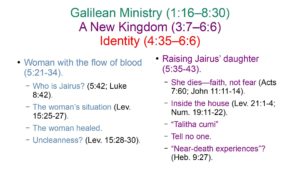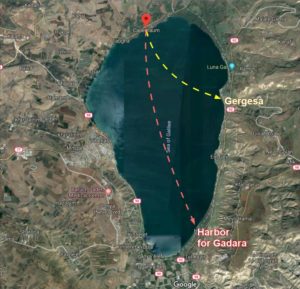The Ministry of Jesus in Galilee
Mark 1:16—8:30
A New King (1:16—3:6).
Kingdom is Near (1:15)
Popularity (1:16-45).
Conflict (2:1—3:6).
Jewish Leaders Reject Him (3:6)
A New Kingdom (3:7—6:6)
Kingdom Has Small Beginnings (4:3)
Continued Conflict (3:7-35).
Parables (4:1-34).
Identity (4:36—6:6).
Calming the Sea (4:35-41).
The formerly demon-possessed man wants to go with Jesus.
Wait, why does Jesus tell this man to tell everyone what happened, but he told the former leper to keep quiet (1:43-44), the demons in several places, even Jairus later in this chapter (5:43)? The people were different. The Gentiles didn’t know what to expect from someone like this, so none of them would have plans to kill Him like the Pharisees and Herodians. Also Jesus wouldn’t be in their area often enough to be swarmed by them. He wanted His message to be carried into regions even He wouldn’t venture far into.
And all marveled at what this man proclaimed (preached).
Healing Woman with Issue of Blood (5:21-34).

This chapter deals with many things that are ceremonially unclean.
The demon-possessed man had an unclean spirit and was living among the dead in the tombs.
This woman we are about to discuss had an issue of blood and was therefore ceremonially unclean.
Jairus’ daughter had died, and dead bodies are also ceremonially unclean.
We had already discussed Jesus blatantly touching a leper who had not been ceremonially cleansed yet when He healed him (Mark 1:40-45), but this chapter zeroes in on the issue.
Later we see what Jesus says about what really defiles a man (Mark 7:20-23).
This healing is sandwiched in the middle of the story of Jairus’ daughter.
First we note that Jesus had listened to the requests of those in Decapolis that He leave them, and He returns across the Sea of Galilee—presumably to Capernaum, though it could be Tiberias or any town on the northern or eastern coast of the sea.

While those in Decapolis urged Him to leave, He is greeted eagerly by the Galileans.
Jairus comes to Jesus. Who is Jairus?
He is the ruler of the synagogue.
This was not a religious role, but an administrative or custodial role.
He was still prominent and well-known in the area.
This may or may not be the same synagogue in which he cast out the demon (Mark 1:21-28) or healed the man with the withered hand (Mark 3:1-6).
Whatever the case, Jairus heard of this Jesus and His power and came to Him when he needed Him most.
He came to Jesus and fell at His feet. Matthew says he worshiped Jesus (Matt. 9:18). Another one in need bows before Jesus, asking humbly of Him.
He had a 12-year-old daughter, his only girl (Mark 5:42; Luke 8:42).
She was sick to the point of death.
Jesus went with Jairus to see his daughter.
The crowd was thick and difficult to get through.
One could imagine the anxiety of Jairus at this point—“we must hurry before it is too late!”
The crowds no doubt slow them down, and then Jesus stops to talk to this woman.
Jairus’ anxiety must be through the roof—Jesus had not yet raised the dead at this point, so they didn’t know He could do that.
The woman with the flow of blood.
There is an interesting connection in that this woman had this issue of blood for twelve years, and the little girl was twelve years old.
She spent all her money on doctors and only got worse.
Mark implies that the doctors actually made her worse.
She law stated she was unclean and anything she sits or lies on was also unclean. Also, anyone who touches such a seat or bed was also unclean. They were to wash their clothes, bathe in water, and be unclean until evening (Lev. 15:25-27). Being unclean meant she could not enter into the temple to worship.
Yet she had much faith. If she could only touch Jesus’ clothes (hem/border of His garment [Matt. 9:20; Luke 8:44]), she would be healed.
But she was unclean, therefore making everyone else who touched her in the crowd unclean, and she risked making Jesus unclean, too.
The woman healed.
She touched Jesus clothes and was healed immediately.
Jesus sensed this and asked, “Who touched My clothes?” – Why did He ask this question? Was it because He didn’t know who touched Him? No, but so that the woman would have an opportunity to announce herself. The goal of asking a question is not always to seek unknown information, though the disciples thought this was the case.
She was fearing and trembling. Why? A couple possibilities: 1) This is Jesus! She might not know exactly who He is yet, but she knows He’s a man of God. 2) She was unclean and now likely made Him unclean. After all, she did just tell Him of her flow of blood and her uncleanness.
Was Jesus now unclean? As we discussed in Mark 1 with the leper, the power had gone out of Him to heal the other person. Jesus might have bathed and washed His clothes later, but it doesn’t say. It’s possible that He waited until evening to see Jairus’ daughter, but there is no indication of this in the text. Whatever the case, Jairus witnessed all this, but didn’t seem to care.
Jesus then reveals that it was her faith that made her well, and that she should be at peace, not worrying about this possible uncleanness.
She feared, but didn’t let that fear stop her because her faith was strong.
Then seven days after this she was ritually clean, and then offered two birds (turtledoves/pigeons) at the temple. One was a sin offering, an offering of purification from her uncleanness, and the other a burnt offering, an atoning sacrifice to bring her closer to God (Lev. 15:28-30).


